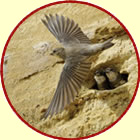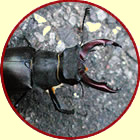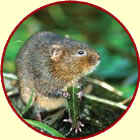 London's BAP
priority
London's BAP
priority
species
London Biodiversity Partnership has identified a total of 214 priority species that are under particular threat in London.
Planning decisions must take these species into account.
Eight of these species (or species groups) have been identified as needing targetted action to secure their future in London, and these have their own Species Action Plans.
However, sensitive management of our priority habitats and delivery of our Habitat Action Plans and habitat targets will support the needs of most of our priority species.
Species briefings are available for selected priority species.
All UK BAP priority species that have an established resident population in London have been adopted as London priority species. Other London priority species have been selected because they are on the UK Red Data List, are scarce in the UK, or are characteristic of London.
We are particularly interested to hear from you if you see any of these species. Find out more about how to tell us what you've seen.
The London Biodiversity Action Plan Priority Species list was last reviewed in 2007. Download the review (360kb).
The reference lists of Species of Conservation Concern in London were also updated in 2007. Download reference lists for:
Plants (1 of 4) .xls 72kb
Fungi (2 of 4) .xls 24kb
Invertebrates (3 of 4) .xls 136kb
Vertebrates (4 of 4) .xls 52kb
Species Action Plans
| 1. bats |
| 2. black poplar |
| 3. house sparrow |
| 4. mistletoe |
| 5. reptiles |
| 6. sand martin |
| 7. stag beetle |
| 8. water vole |
Other Important Species
| 9. black redstart |
| 10. common dormouse |
| 11. grey heron |
| 12. otter |
| 13. peregrine |
1. Bats
London is home to at least eight species of bat. A couple of generations ago, people talked of 'clouds of bats' rising across the Thames - but not today. City bats increasingly rely on buildings to roost.
The London Bat Group leads on our Bats Species Action Plan, which is currently under review. Progress on the Bats SAP will be reported on BARS.
LBP partners, householders and developers can take action to protect and encourage bats. Download guidance on bat roost creation in London, the impact of lighting on bats and Managing Trees and Woodlands for Bats in London.
Bats: European protected species (Natural England) .pdf 42kb
2. Black poplar
The black poplar - once a symbol of fertility - perversely has suffered its own massive decline. Black poplar timber was once used for making rifle butts, broom handles, toys and even Venetian blinds. Now, the old age of London's surviving black poplars means that they need our help to survive.
The Natural History Museum leads our Black Poplar SAP Group and the Black Poplar Species Action Plan. Progress on the Black Poplar SAP will be reported on BARS. The group is conducting a genetic study of London's remaining black poplars. Contact Fred Rumsey (f.rumsey[at]nhm.ac.uk*) to keep in touch with the work of the group.
3. House sparrow
The once familiar 'Cockney sparrer' has suffered a massive drop in numbers. The Partnership is working to discover the root cause of the sparrow's decline, while increasing public awareness of its plight.
The London House Sparrow Parks Project and Cockney Sparrow Project are key elements in the delivery of our House Sparrow Species Action Plan. Progress on the House Sparrow SAP will be reported on BARS.
Contact Jacqueline Weir (Jacqueline.Weir[at]rspb.org.uk*) to get involved with the work of the House Sparrow SAP group.
4. Mistletoe
A sacred pagan symbol, mistletoe has been a symbol of peace and goodwill throughout the ages. It is a parasitic plant, growing in the branches of deciduous trees. A lot of mistletoe has been pruned out of trees.
Our Mistletoe Species Action Plan is currently under review. Progress on the Mistletoe SAP will be reported on BARS.
Download Christmas curiosity or medical marvel? A seasonal review of mistletoe or visit the Mistletoe Pages for more information about this intriguing species.
5. Reptiles
London has its own 'micro-climate', several degrees warmer than the surrounding countryside, making it attractive to reptiles. Slow worm, adder, grass snake and common lizard are threatened in London by a lack of understanding and persecution.
The HLF-funded CLARE Project (Connecting London's Amphibian and Reptile Environments) is delivering the targets in our Reptiles Species Action Plan. Progress on the Reptiles SAP will be reported on BARS.
Land managers can learn how to make their land more reptile-friendly using the Reptile Habitat Management Handbook.
6. Sand martin
Darting over the water to catch insects, sand martins are a familiar summer sight to Londoners living and working near waterways. But their numbers are declining due to droughts in sub-Saharan Africa, where they spend their winters, and loss of summer breeding grounds in London. The Partnership is creating artificial nesting banks as part of our Sand Martin Species Action Plan. Progress on the Sand martin SAP will be reported on BARS.
Land managers can learn how to make room for sand martins using the Best Practice Guidelines for creating sand martin banks and towers.
Partners should contact Martyn Foster (martyn.foster[at]rspb.org.uk*) to get involved with the work of the Sand Martin SAP group.
7. Stag beetle
The UK's largest ground-living beetle, the stag beetle, has a fearsome appearance and reputation. London is a stag beetle hotspot, with thirty percent of the UK's recorded population in our woods, parks and gardens. The Partnership is working to improve awareness of the value of the dead wood in which stag beetle larvae live, and creating artificial stag beetle 'loggeries'.
Our Stag Beetle Species Action Plan is currently under review. Progress on the Stag beetle SAP will be reported on BARS. Partners should contact Mathew Frith (mfrith[at]wildlondon.org.uk*) to get involved.
Download our advice note on stag beetle conservation.
8. Water vole
Since Kenneth Graham first introduced generations of readers to the loveable Ratty in 'Wind in the Willows' his real-life counterpart, the water vole, has suffered an alarming drop in its population. The London Water Vole Project is delivering our Water Vole Species Action Plan through its highly successful reintroduction programme, and by raising public support for this engaging creature. Progress on the Water Vole SAP will be reported on BARS.
Partners should contact Mathew Frith (mfrith[at]wildlondon.org.uk*) to join the Water Vole SAP group.
Planners and developers can download guidance on protecting water voles in development.
Oher Important Species
9. Black Redstart
An iconic figure of London's wildlife, the black redstart is a recent arrival from Europe. The appearance of this bird on London's wastelands during the Second World War led it to be nicknamed the 'bomb-site bird'. There was a London SAP for the Black Redstart until 2008, and it is still a London priority species.
Black Redstart: Advice for its conservation in London (London Wildlife Trust) .pdf 129kb
10. Common Dormouse
The Common Dormouse is a London priority species.
Dormouse: European protected species (Natural England) .pdf 231kb
11. Grey Heron
At the top of the food chain, any decline in water quality or food supply has a knock-on effect on grey heron populations. There was a London SAP for the grey heron until 2008.
Grey Heron fact sheet for adults
Grey Heron fact sheet for children
12. Otter
The Otter is a London priority species.
Otter: European protected species (Natural England) .pdf 66kb
13. Peregrine Falcon
We easily forget how our city appears to our airborne neighbours. London's patchwork of buildings provides homes for these spectacular birds. There was a London SAP for the Peregrine until 2008, and it is still a London priority species.
Peregrine Falcons: provision of artificial nest sites on built structures (London Biodiversity Partnership) .pdf 324kb
Peregrine Falcons: An advice note about nesting on buildings in London (Natural England) .pdf 62kb
Visit the London Peregrine Partnership or the London Peregrines group
*To prevent spam, we have removed the '@' from all e-mail addresses on this website. To get in touch, simply copy the e-mail and replace '[at]' with '@'














